Seasons – January 2023

From the Plateau Land & Wildlife Management Team
Whew. The new year has rung in. Winter is upon us and cold weather has arrived in Texas.
With 2023 underway, property taxes are on the forefront of many of our landowners’ minds. Not only are property tax bills due, but now is the time to file certain late protests or motions to correct appraisal rolls. The beginning of the year is also a great time to consider your property tax valuations, and to begin preparing if you plan to make the switch to Wildlife Management.
This Seasons Newsletter is full of helpful considerations and tips for landowners including articles and blogs from our expert team of biologists and property tax consultants, attorneys from Braun and Gresham LLC, and more. Read blogs and articles covering open space valuations, property tax deadlines, invitations to virtual events covering your property tax valuation options, and more.
Though 2022 has drawn to a close, being proactive with your property taxes in 2023 can help to ease the burden of transitioning in the new year. As always, we’re here to help if you need us.
Until next Seasons,
The Plateau Team
Table of Contents
New Year’s Resolutions for Landowners
Winter Visitors to Your Bird Nest Boxes
Service Spotlight: Winter Webinar Series
We’re Hiring! Join the Plateau Team!
Avoiding Common Property Tax Pitfalls
News for Texas Landowners
New Year’s Resolutions for Landowners
By PLW Staff
The start of a new year is the perfect time for evaluation – a time of reflecting and looking forward.
As you make plans for the new year, start by taking some time to review the Wildlife Management Plan for your property. Take note of the recommended activities in the plan for this year. Then, take a walk around your property to see if the plan and the land are in sync. If the property has changed (ice storm, wind event, drought) or your objectives have changed (managing for whitetail or improving native plant populations,) the plan may need an update. Be sure to add some notes to your management plan about any changes, as well as your observations about the property.
You can also use this guide of commonly needed stewardship practices – resolutions if you will – to create a list of activities. Or, work backwards: create a vision for what you want your property to look and feel like, then determine what practices will best help you reach those goals.
- Improve butterflies, bees, and other pollinator populations by spreading native wildflower seed this spring.
- Keep accurate logs of your management activities by keeping a logbook nearby; at your property, or in the vehicle/UTV you use around the property.
- If your property changed in size (such as adding acreage or selling off any acreage) or the legal ownership changed (transferred from a property owner’s name to an LLC) landowners must update/refile their plan and submit a new application with their Central Appraisal District.
- Learn which species to watch for on your own property by tracking bird migration forecasts in real-time and with tools like BirdCast.
- Create a monthly maintenance calendar. Include reminders for important tasks, such as refilling feeders, as well as maintenance items, such as brush clearing or fire ant treatment.
- Pick the seed head from grasses and blooms you like on your property and replant. They’re growing natively for a reason.
- Evaluate and track wildlife populations on your property with Camera Surveys.
- Nurture native bird species by completing any brush management before the bird breeding season in March.
- In the late Spring, remember to walk a field before mowing, and look out for any newborn fawns.
- Plan summertime projects now. If you’re DIYing, you’ll be ready to roll at the first hint of nice weather. If you’re hiring a contractor or other professional, getting your bids and contracts in place now will save you from competing with the spring rush.
- Clean out nest boxes and remove any debris or leftover nesting material from the previous year
- Late winter through spring is an ideal time to reduce feral hog numbers before spring nesting/fawning.
- Remember, not all predators need to be removed. That rat snake that scared you up a tree is the perfect natural pest control for mice and rats.
- For the best chance of growth, plant woody plants such as trees and shrubs in the winter.
- Don’t be so quick to burn that brush you cleared; brush piles make perfect shelters for small critters looking to escape the elements.
- Take advantage of native plants to minimize erosion and improve soil health. Plants are the natural solution for many conservation challenges.
- Utilize maps when possible, mark areas where feeders, water sources, nest boxes, etc. are located. Draw areas where brush management, erosion control, fire ant treatment, etc. occur.
- Explore new technology: property management innovations can help landowners accomplish goals more efficiently. For example, live video feed game cameras, which allow users to log in and stream live video of their property directly to their phone, are a great option for security as well as monitoring wildlife.
As a property owner, making and following through on resolutions to manage and improve your property will pay dividends this year and beyond. As property tax bills come due, now is the time to file certain late protests or motions to correct appraisal rolls. The beginning of the year is also a great time to consider your property tax valuations, and to begin preparing if you plan to make the switch to Wildlife Management. Don’t let it stress you out. Call Plateau and ask for help and guidance.
If you have questions or would like more information about appropriate Wildlife Management activities for your property, please contact us at (512) 894-3479 or [email protected].
Back to TopBack to Top
Winter Visitors to Your Bird Nest Boxes
By Shane Davis, Staff Biologist

An adult ringtail peers out from a Plateau Nest Box
While Texas tends to enjoy a much milder winter compared to other places, we still get occasional fronts and cold snaps that rush in and drop temperatures quickly. When these freezing temperatures arrive we like to bundle up and stay inside as much as possible, and wildlife is no different. If you have bird nest boxes, or birdhouses, for breeding birds in the spring, you may be surprised to find a wide variety of species inhabiting the boxes during the colder months.
First and foremost, while few birds breed and nest outside of early spring to mid-summer, many of the birds that stay in Texas and do not migrate will use the boxes on cold nights as roosts. Which species will use your boxes varies depending on many factors, including the size of both the entrance hole and the overall interior space. Some species documented include Woodpeckers, Bluebirds, and other resident songbirds such as Titmouse and Chickadees. Typically the birds do not build any sort of nest or bedding for this, and merely take shelter in the empty box. Some research on this has found that the temperature within a nest box can be up to ten degrees warmer than the outside air. This may not seem like much to us, but to a small bird like a Chickadee, there’s a great deal of difference between 20 and 30 degrees.
However, it’s not just birds who want to escape the cold and seek shelter within your nest boxes. Nearly all manner of snakes and frogs that climb well can be found inside the boxes. The warmth the boxes provide is even more crucial to these species, as they are cold-blooded and cannot move if the outside temperature is too low.
One group that can often be found using the boxes is rodents, and if you know what to look for, the evidence of their stay can be seen even after they’ve left. Rodents like to pack the boxes with a hefty clump of wood shavings to keep extra warm. Anything from small Field Mice, to Flying Squirrels, Fox Squirrels and even Ringtail can be found bedding down in your nest boxes, as seen in the photo at right. While they are relatively harmless, it’s always a good idea to clean out this bedding before the start of the breeding season so your nest boxes are free for the birds to make their nests. Just make sure to be gentle, as the mice often hide deep within the bedding and will only come out as a last resort.
Back to TopBack to Top
Service Spotlight: 2023 Winter Webinar Series

Ready to learn more about Wildlife Management options for your property?
Join us 5:45 – 7:00 pm each Tuesday evening from now to March 14 as Plateau Land Specialists and Staff Biologists host FREE educational webinars for landowners. Whether you’re a new landowner or already in Ag or Timber, everyone is invited to join us for our 2022 Wildlife Exemption Webinar Series. Connect with experts and learn how to make the switch to a Wildlife Management Exemption.
Listen along from your computer as our experts cover a variety of land ownership, wildlife management, and Texas ag exemption topics. Get answers to your questions about making the switch, learn about filing deadlines, requirements for activities and record-keeping, and more.
Special Landowner Topics Presented By: Texas Agrilife, Big Thicket Beekeeping, TREAD Coalition, Capital Farm Credit, The Modern Texas Naturalist, and Braun & Gresham.
View topics and featured speakers and register for upcoming events by visiting Plateau’s Event Directory. For questions or more information, contact [email protected] or (512) 894-3479.
We’re Hiring! Join the Plateau Team!
 Our team is growing – join us! PLW is hiring multiple Wildlife Services Technicians in Central Texas!
Our team is growing – join us! PLW is hiring multiple Wildlife Services Technicians in Central Texas!
Job responsibilities include installing and servicing wildlife feeders, songbird nesting boxes, and rainwater collection systems, surveying and treating for Imported Red Fire Ants, brush management, herbicide application for prickly pear control, spotlight or game camera deer surveys, and data collection/field documentation. Once trained, Wildlife Services Technicians will work solo or in teams with other Wildlife Services Technicians performing these services and more for our landowner clients throughout our Central Texas Region.
Plateau Land & Wildlife Management has been helping rural landowners protect and enhance their land since 1997. Today, our team of certified wildlife biologists, registered property tax consultants, wildlife services technicians, and full staff set us apart from everyone else. No other company has a greater depth of knowledge in wildlife or provides a wider variety of land and wildlife-related products and services.
Ready to join? Learn more at https://plateauwildlife.com/careers/
Back to TopBack to TopAvoiding Common Property Tax Pitfalls
By Cassie Gresham, Braun & Gresham Attorney and Counselor

My work on behalf of landowners often involves helping them fix a problem or get out of a bind with their local appraisal district. Through the years, I have seen some common mistakes that can lead to big problems:
- Be aware of the deadline to file your annual report
Did you know that there is no state statute setting a deadline for annual reports? Therefore, many appraisal districts set their own deadlines for filing annual reports. You should know exactly what the deadline is each year in your particular county. - Be able to document your use of your property for open space
Landowners should have a written lease for their property to document who is using their property and how their property is being used for agricultural use. If you are using your property for wildlife management, then you should have an up to date wildlife management plan that you are following. When you implement the wildlife management activities on your property, you should document (take pictures, keep a journal, etc.) your work. - Was there an ownership change? You must re-file your application
You need to re-file an application in your own name if you have recently purchased a property. But, you also need to re-file an application even if you are just transferring the property into a new entity that you still own (i.e. LLC, LLP, Trust). Failure to file a new application will result in the loss in your open space valuation. - Always review your Notice of Appraised Value
The Notice of Appraised Value usually arrives in April/May each year. It shows you not only what the market value of your property will be for that year, but it also indicates whether or not your property will qualify for an open space valuation. Many appraisal districts consider the Notice of Appraised Value as the notice they provide if there is a problem. - Make sure to protest
You should protest each year if your property value has increased above the market value or is not being taxed in a similar manner to your neighbors. You should also protest if your ag or wildlife management valuation has been removed. You typically have 30 days to protest from the date that you receive notice that your ag or wildlife management has been removed. Or you should file a protest no later than May 15th, whichever is later. You can file a late protest, but you should file it before the appraisal district certifies their tax rolls. The certification usually occurs in late July. - Make sure to pay your taxes by January 31st
You should pay your taxes by January 31st of each year, even if you have filed a protest and are waiting on a hearing or waiting on a lawsuit to be resolved. If you have lost your ag or wildlife management valuation and have filed a timely protest, then you at least need to pay the amount not in dispute or the amount of taxes you paid last year when you had an ag valuation. Failure to pay the taxes (even the undisputed amount) will result in a forfeiture of your protest or lawsuit. - Know the agricultural history of a property you are purchasing
Ask the seller to provide documentation of approval of the ag or wildlife management use before you purchase the property. You want to obtain any written leases or evidence of practices that have been implemented on the property prior to closing. When you make an application in your own name, you might be asked by the local appraisal district to demonstrate the history of use of the property. You will only have this information if you have previously requested it from the seller as part of your due diligence in purchasing the property. - Continue your use of the property for ag or wildlife management, even if you don’t qualify
Even if your property didn’t qualify for ag or wildlife management in a particular, you should continue the use of the property for ag or wildlife management use. This will allow you to avoid rollback taxes by demonstrating that there is no change in use in the property. - Additional notice is required to landowners who are over 65
In 2015, the Texas Legislature passed a law that requires additional notice to landowners who are over 65. If a chief appraiser believes there is a change in use of the property, then they are required to provide notice to the over 65 landowner. If the chief appraiser doesn’t receive a response within 60 days, then they are required to follow up with the landowner. This new law provided additional protection for landowners and a higher standard for appraisal districts. Most appraisal districts are not aware of this additional notice and fail to provide it. - Communicate your local appraisal district
Haven’t heard from your local appraisal district by April 1st? Call them. Many of the problems that we have to solve are due to lack of notice. If you are talking to your local ag appraiser, you are more likely to know if there is a problem. Why do I suggest the date of April 1st? Because it still gives you time to solve any problems that need to be addressed (i.e. file a new application, annual report or a protest).
If you have questions or concerns about your property tax status, bill, or filing a protest, Braun & Gresham can help. The attorneys at Braun & Gresham are not only experts and innovators in ways to utilize property tax incentives and how to reduce your property taxes, but we also serve as your advocates when you are unfairly taxed. We know the rules and how to use them. We also make sure the taxing authorities follow those rules. Please contact us at (512) 894-5426 or email [email protected].
News for Texas Landowners
Hays County expands conservation land to 3,200 acres
Article by KXAN

HAYS COUNTY, Texas (KXAN) – Hays County is now home to one of the state’s largest area of wilderness, open space and water quality protection land. That’s after it partnered with an organization and a developer to make sure an area in San Marcos remains untouched.
Frank Davis with the Hill Country Conservancy said it all started when La Cima, a housing developer, approached them about 1,068 acres of land they owned.
“There are caves, sinkholes, cracks, fissures, all sorts of ways in which the water makes its way directly down into the aquifer with no filtration. So this is an extremely sensitive property,” Davis said.
Case Illustrates Importance of Farm Leases Being in Writing
Article by Texas Ag Law Blog

Candido John Coniglio, Sr. (“Senior”) owned a 5,100 acre farm in Fannin County which was managed by his son, Candido John Coniglio, Jr. (“Junior”). Michael Woods owned the adjacent farm.
Woods hired workers to cut hay on his property. Senior agreed to allow Woods to cut and bale 107 acres of hay on Senior’s property in exchange for giving Woods a portion of the hay crop with Woods getting 60% and Senior and Junior getting 40%. Starting in 2015, Woods cut Senior’s hay based on this oral agreement. Senior and Junior testified this oral agreement was on a year-to-year basis, but Woods claimed he and Junior entered into a five-year lease of the farm, which would allow him to cut and bale hay until December 31, 2020.
Texas landowners save by saving wildlife
Article by Austin American Statesman

David Prickett likes to say that the best part of his property, a few miles south of the Central Texas city of Bulverde, is the pit that used to be an active stone quarry. Forty-foot-high limestone walls surround the site. Nature has begun reclaiming the land with shrubs, trees and prickly grasses. At sunset, Prickett often walks his dog, Silhouette, to the former quarry to catch glimpses of wildlife as sunlight bounces off the rock. The only sounds are the distant rumble of traffic on U.S. 281and the buzz of construction just across the quarry pit, where a 1,000-home subdivision is being built. ‘With all this development growing around us, wildlife comes here, to this land. They need a place to go,’ Prickett said. ‘Soon enough, this will be the only natural area for miles.’
Conservation efforts for Texas horned lizard stall after wildlife funding fails to pass Congress
ARTICLE BY SAN ANTONIO

TEXAS — Texas conservationists just missed out on millions of dollars to protect critical wildlife and ecosystems vital to the state. The Recovering America’s Wildlife Act (RAWA) failed to pass through U.S. Congress, which would’ve allotted millions of dollars annually to conservation efforts that are often overlooked or left out of funding opportunities.
And one of those projects is to help restore Texas’ state reptile, the horned lizard.
There are 50 breeding lizards at the San Antonio zoo’s Texas Horned Lizard Re-introduction Project. This species is state listed as threatened, which means you can’t buy, sell or take it out of the wild. Their populations are dwindling and so is their habitat. The exact cause of the Texas horned lizard decline is still unknown, but one of the main factors is loss of habitat from development.
Texas State Parks Celebrating 100 Years with Special Events throughout 2023
Press Release by TPWD

AUSTIN— The Centennial Celebration of Texas State Parks kicked off on Jan. 1 with First Day Hikes at every state park in Texas. To commemorate 100 years, every state park will host at least one special event during the 2023 Centennial year. In January, state parks in North Texas and on the coast will host rainbow trout kid fishing events. Everyone is invited to join in the fun. The Trout Kids Derby- 100 Years Celebration will take place on Jan. 7 from 9 a.m. to 1 p.m. at the Kid Fish pond at the Johnson Branch Unit at Ray Roberts Lake State Park. Park rangers will be on hand to assist, and there will be prize giveaways. On Jan. 28, Lake Corpus Christi State Park will host its annual Kid Fish event from 9 a.m. to 2 p.m. Children ages 5-12 are invited out to try their hand at fishing for rainbow trout stocked by TPWD and learn more about fishing and the outdoors.
Thorns and All: Conservation Partners Show Love to Thornscrub Habitat in South Texas
Article by Aubry Buzek for U.S. Fish & Wildlife Service

When approaching a thicket of the “mean and thorny” plants that make up Tamaulipan thornscrub habitat, it’s easy to initially question how anyone could comfortably live in or with it. Even early explorers in South Texas’ Lower Rio Grande Valley wondered what to make of it. “Could all this thorny jungle and chaparral have been created in vain?” asked Rio Grande Valley ethnographer Capt. John. G. Bourke in 1895. “No… the more we examine into the great scheme of nature, the more do we see that nothing has been made without some purpose.”
This essential habitat hosts more than 1,200 plant species, 519 bird species, and 316 butterfly species, including 45 federal and state threatened or endangered species, in one of the most biologically diverse regions in North America.








Sorry, the comment form is closed at this time.